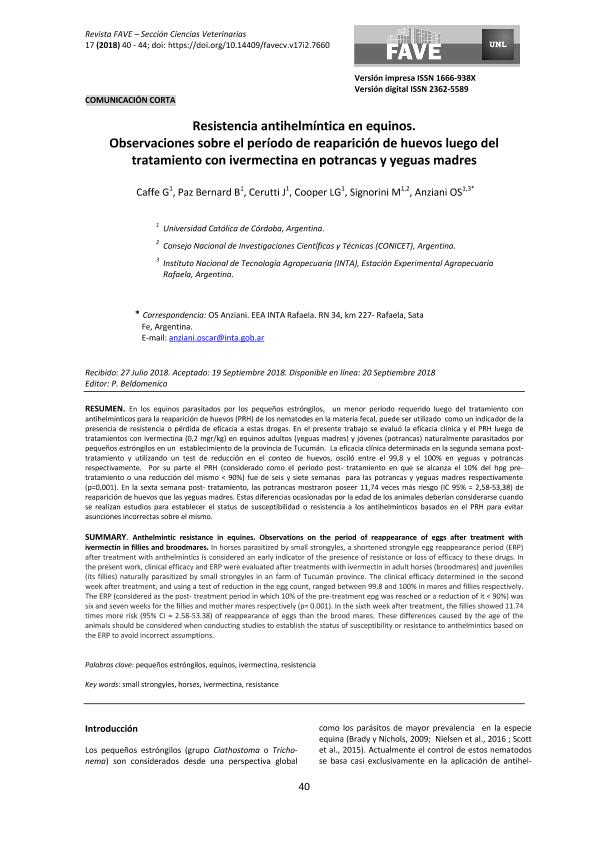Mostrar el registro sencillo del ítem
dc.contributor.author
Caffe, G.
dc.contributor.author
Paz Bernard, B.
dc.contributor.author
Cerruti, Juan

dc.contributor.author
Cooper, Laura Gabriela

dc.contributor.author
Signorini Porchietto, Marcelo Lisandro

dc.contributor.author
Anziani, Oscar Sergio

dc.date.available
2022-02-23T12:32:16Z
dc.date.issued
2019-06
dc.identifier.citation
Caffe, G.; Paz Bernard, B.; Cerruti, Juan; Cooper, Laura Gabriela; Signorini Porchietto, Marcelo Lisandro; et al.; Resistencia antihelmíntica en equinos: Observaciones sobre el período de reaparición de huevos luego del tratamiento con ivermectina en potrancas y yeguas madres; Universidad Nacional del Litoral; Fave Ciencias Veterinarias; 17; 2; 6-2019; 40-44
dc.identifier.issn
1666-938X
dc.identifier.uri
http://hdl.handle.net/11336/152580
dc.description.abstract
En los equinos parasitados por los pequeños estróngilos, un menor período requerido luego del tratamiento con antihelmínticos para la reaparición de huevos (PRH) de los nematodes en la materia fecal, puede ser utilizado como un indicador de la presencia de resistencia o pérdida de eficacia a estas drogas. En el presente trabajo se evaluó la eficacia clínica y el PRH luego de tratamientos con ivermectina (0,2 mgr/kg) en equinos adultos (yeguas madres) y jóvenes (potrancas) naturalmente parasitados por pequeños estróngilos en un establecimiento de la provincia de Tucumán. La eficacia clínica determinada en la segunda semana post-tratamiento y utilizando un test de reducción en el conteo de huevos, osciló entre el 99,8 y el 100% en yeguas y potrancas respectivamente. Por su parte el PRH (considerado como el período post- tratamiento en que se alcanza el 10% del hpg pre-tratamiento o una reducción del mismo < 90%) fue de seis y siete semanas para las potrancas y yeguas madres respectivamente (p=0,001). En la sexta semana post- tratamiento, las potrancas mostraron poseer 11,74 veces más riesgo (IC 95% = 2,58-53,38) de reaparición de huevos que las yeguas madres. Estas diferencias ocasionadas por la edad de los animales deberían considerarse cuando se realizan estudios para establecer el status de susceptibilidad o resistencia a los antihelmínticos basados en el PRH para evitar asunciones incorrectas sobre el mismo.
dc.description.abstract
Anthelmintic resistance in equines. Observations on the period of reappearance of eggs after treatment with ivermectin in fillies and broodmares. In horses parasitized by small strongyles, a shortened strongyle egg reappearance period (ERP) after treatment with anthelmintics is considered an early indicator of the presence of resistance or loss of efficacy to these drugs. In the present work, clinical efficacy and ERP were evaluated after treatments with ivermectin in adult horses (broodmares) and juveniles (its fillies) naturally parasitized by small strongyles in an farm of Tucumán province. The clinical efficacy determined in the second week after treatment, and using a test of reduction in the egg count, ranged between 99.8 and 100% in mares and fillies respectively. The ERP (considered as the post- treatment period in which 10% of the pre-treatment epg was reached or a reduction of it < 90%) was six and seven weeks for the fillies and mother mares respectively (p= 0.001). In the sixth week after treatment, the fillies showed 11.74 times more risk (95% CI = 2.58-53.38) of reappearance of eggs than the brood mares. These differences caused by the age of the animals should be considered when conducting studies to establish the status of susceptibility or resistance to anthelmintics based on the ERP to avoid incorrect assumptions.
dc.format
application/pdf
dc.language.iso
spa
dc.publisher
Universidad Nacional del Litoral
dc.rights
info:eu-repo/semantics/openAccess
dc.rights.uri
https://creativecommons.org/licenses/by-nc-sa/2.5/ar/
dc.subject
PEQUEÑOS ESTRÓNGILOS
dc.subject
EQUINOS
dc.subject
IVERMECTINA
dc.subject
RESISTENCIA
dc.subject.classification
Ciencias Veterinarias

dc.subject.classification
Ciencias Veterinarias

dc.subject.classification
CIENCIAS AGRÍCOLAS

dc.title
Resistencia antihelmíntica en equinos: Observaciones sobre el período de reaparición de huevos luego del tratamiento con ivermectina en potrancas y yeguas madres
dc.title
Anthelmintic resistance in equines: Observations on the period of reappearance of eggs after treatment with ivermectin in fillies and broodmares
dc.type
info:eu-repo/semantics/article
dc.type
info:ar-repo/semantics/artículo
dc.type
info:eu-repo/semantics/publishedVersion
dc.date.updated
2020-11-18T21:22:45Z
dc.journal.volume
17
dc.journal.number
2
dc.journal.pagination
40-44
dc.journal.pais
Argentina

dc.journal.ciudad
Santa Fe
dc.description.fil
Fil: Caffe, G.. Universidad Católica de Córdoba. Facultad de Ciencias Agropecuarias; Argentina
dc.description.fil
Fil: Paz Bernard, B.. Universidad Católica de Córdoba. Facultad de Ciencias Agropecuarias; Argentina
dc.description.fil
Fil: Cerruti, Juan. Universidad Católica de Córdoba. Facultad de Ciencias Agropecuarias; Argentina
dc.description.fil
Fil: Cooper, Laura Gabriela. Universidad Católica de Córdoba. Facultad de Ciencias Agropecuarias; Argentina
dc.description.fil
Fil: Signorini Porchietto, Marcelo Lisandro. Universidad Católica de Córdoba. Facultad de Ciencias Agropecuarias; Argentina. Consejo Nacional de Investigaciones Científicas y Técnicas. Centro Científico Tecnológico Conicet - Córdoba; Argentina
dc.description.fil
Fil: Anziani, Oscar Sergio. Instituto Nacional de Tecnología Agropecuaria. Centro Regional Santa Fe. Estación Experimental Agropecuaria Rafaela; Argentina. Universidad Católica de Córdoba. Facultad de Ciencias Agropecuarias; Argentina
dc.journal.title
Fave Ciencias Veterinarias

dc.relation.alternativeid
info:eu-repo/semantics/altIdentifier/url/http://bibliotecavirtual.unl.edu.ar/publicaciones/index.php/FAVEveterinaria/article/view/7660
Archivos asociados
